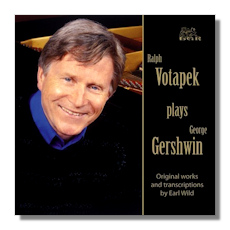
The Internet's Premier Classical Music Source
Related Links
- Gershwin Reviews
- Latest Reviews
- More Reviews
-
By Composer
-
Collections
DVD & Blu-ray
Books
Concert Reviews
Articles/Interviews
Software
Audio
Search Amazon
Recommended Links
Site News
 CD Review
CD Review
George Gershwin

Original Works and Transcrptions
- Promenade
- George Gershwin's Songbook
- 3 Preludes
- Earl Wild:
- Grand Fantasy on Themes from Porgy and Bess
- Virtuoso Etudes after Gershwin:
- #2, Oh, lady, be good
- #4, Embraceable you
Ralph Votapek, piano
Blue Griffin BGR139 61:36
Summary for the Busy Executive: Fascinatin', elusive rhythm. A schizophrenic disc.
Gershwin wrote few concert works, and most of those have entered the repertory. I never thought I'd live to see several competing versions of the complete Porgy and Bess, one of them led by Harnoncourt, a near-total Eurocentrist. During his brief life, Gershwin poured most of his creative effort into Broadway musicals and movies and became one of the great songwriters. I prefer him to Hugo Wolf.
Much of Gershwin's written solo piano music consists of sketches. The list of complete pieces runs short, but contains music of high quality. Several recordings have appeared, including recordings of Gershwin himself on either piano rolls or the radio. By most accounts, Gershwin was a master pianist, although his recordings are uneven. He didn't seem to have a conception of an ideal interpretation of his music but tended to play it the way he felt at the time. This probably grew out of his habit of improvising, both for composition and as a guest who entertained at swank parties. From these improvisations came George Gershwin's Songbook, 18 songs consisting of a standard piano-vocal arrangement and a virtuoso "break" composed by Gershwin himself. The book, incidentally, stands among the great American publishing ventures of the Twenties in terms of conception and design.
Ralph Votapek, a student of Rosa Lhevinne among others, has long experience with Gershwin's piano works. I eagerly waited for this disc and then succumbed to general disappointment. My discontent comes down to two points, one more serious than the other. First, Gershwin's music inhabits a fluid space between classical and pop. You can't play merely the notes. Gershwin himself said he couldn't notate exactly what he meant, even though his markings and directions often go on a good long time. I've heard pianists give really good performances playing Gershwin as they'd play Chopin – a legitimate point of view and probably the best option for a classically-trained pianist. But the music also possesses a strong jazz-influenced pop element that tempts some players to attempt a "swinging" interpretation. Votapek falls into this trap. He doesn't really have the rhythmic freedom of the jazz master in his fingers. He plays too stiffly, from the opening Promenade (the "Walking the Dog" sequence from the Astaire film Damsel in Distress) through most of the Songbook. He performs spectacular feats of virtuosity (especially in the second chorus of "I Got Rhythm"), but it's a little like hearing the Wagnerian Helen Traubel warble "I've Got a Right to Sing the Blues." William Bolcom (Nonesuch 79151), with far less technique than Votapek, nevertheless has the idiom.
Second, throughout Gershwin's long reception, we very seldom heard what the composer actually wrote. Because pop songs can be arranged, publishers decided to apply this approach to the concert works, almost always issuing less interesting music. Gershwin wasn't allowed to fail on his own. I don't mean something like Robert Russell Bennett's Symphonic Picture of Porgy and Bess, because it made no claims to authenticity. Gershwin's own publishers put out things like An American in Paris, silently "improved" by journeyman editors. This is what orchestras played in both recording and the concert hall. It took nearly fifty years to hear the major works as Gershwin had conceived them. Votapek adds little "touches" that change what Gershwin wrote, and I find them, for the most part, in terrible taste and ultimately patronizing. Votapek reaches the nadir of this strategy in the 3 Preludes. If they bore him enough to drive him to futzing, he shouldn't play them in the first place.
Fortunately, we get to the Earl Wild transcriptions, a worthy appendage to the Gershwin canon, just as Liszt's orchestration of "Erlkönig" adds something to Schubert. Wild's Grand Fantasy on Themes from Porgy and Bess stands in the tradition of the Liszt operatic fantasies, exploiting the known resources of the piano and inventing new ones not only to show off the virtuoso but to tell the story. He visits not only the hits, but some instrumental sequences not so well known. I'd call the writing "orchestral," not only for the climaxes, but for the variety of texture and color. Then there's just the simple amazement that so much music comes from one performer. I think it an extraordinary piece. Votapek comes into his own here, at least equaling Wild himself (Ivory Classics 70702). The rhythmic awkwardness has disappeared from his playing, mainly, I believe, because he plays music rather than his notion of "symphonic jazz." The two etudes (on "Lady, Be Good" and "Embraceable You") are quieter affairs, full of Chopinesque calm. Again, Votapek gets in the pocket of these works, which makes me wonder whatever happened to him in the Songbook. Earl Wild has recorded all seven etudes – on Ivory Classics 70702 and on Philips 456991-2, as part of the "Great Pianists of the 20th Century" series).
Copyright © 2011, Steve Schwartz.




















